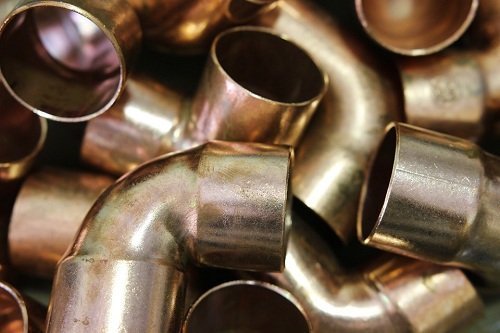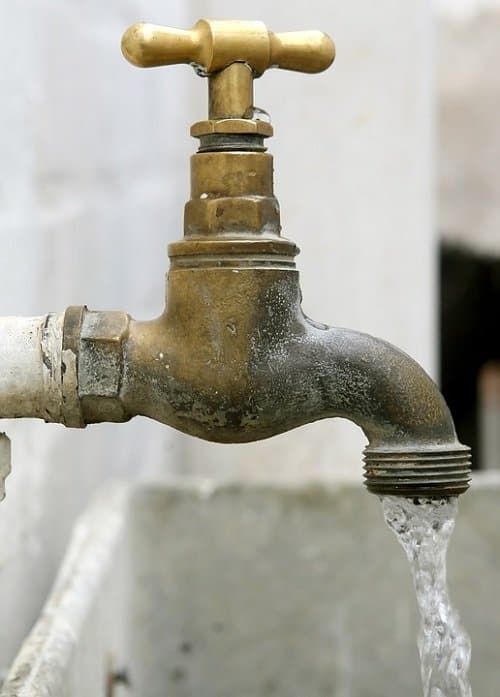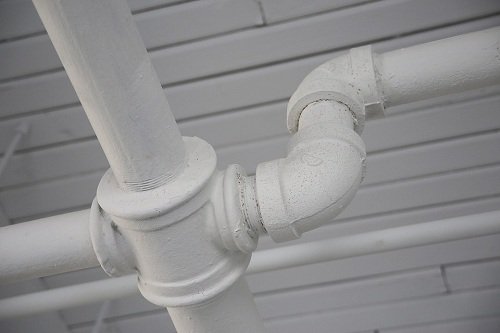Plumbing is often the most complicated aspect of a kitchen or bathroom remodeling project. Your plumbing design must conform to building codes to prevent dangerous and unhealthy conditions.
For many DIYers, understanding local plumbing codes is often a confusing subject. To make sure your DIY bathroom or kitchen renovation is up to code, this section highlights common plumbing codes, including how to choose the right plumbing fittings, how to discover leaks, and how to find plumbing code requirements for your city.
The National Uniform Plumbing Code
Before you embark on your bathroom or kitchen remodeling project, the first code to observe is the National Uniform Plumbing Code which applies generally to the entire country.
This model code was developed by the International Association of Plumbing and Mechanical Officials (IAPMO) to help govern the installation and inspection of plumbing systems and by extension promote the public’s health, welfare, and safety.
Common Plumbing Codes
Next, you must follow local codes, which are often more stringent and apply to specific jurisdictions. When planning your bathroom or kitchen remodeling project, you need to first request information about plumbing codes from your local building department.
Prepare the plans and have them approved by the building department before starting the projects, and ensure that everything is executed to the satisfaction of the inspector. Your plan should also include a list of all materials you will use for the renovation project.
With everything in place, here are the common plumbing codes you need to observe to ensure a successful bathroom or kitchen remodeling project:
1: Proper Venting
Venting is a critical aspect of any plumbing work. Failure to properly vent drainpipes can leave you with a sluggish drainage system that can release noxious fumes into the house, triggering a myriad of health risks.
2: Proper Placement Of Fixtures
Plumbing fixtures must not be installed too close together. This is particularly important in the bathroom where space might be minimal.
3: Correct Pipe Sizes
Determine the right pipe sizes for vents, drains, and supply lines. Again, these codes vary by jurisdiction, so be sure to get the accurate sizes from your building department.
4: Correct Pipe Material
Determine the correct pipe materials. Most building inspectors will accept PVC for drain lines and rigid copper pipe for supply lines.

5: Adequate Water Pressure
To ensure adequate water pressure, you may need to replace any existing globe shutoff valve with a gate valve or full-bore ball that does not hinder the flow of water. If the pressure is too low, you might need to install a booster pump, and where pressure is too high, you might need to include a pressure-reducing valve.

6: Maintaining The Structural Integrity Of The Building
The installation of plumbing fixtures must not weaken the structure of the house. The building inspector may require that you reinforce any joist that has been cut to accommodate pipes. Other code requirements include installing fire caulking around pipes and placing protective plates over pipes.
7: Purchase The Right Fittings
When drawing your plumbing plan, list down the list of all fittings you’ll require. This will help you purchase the right ones that adhere to the code. Always use special drain fittings like closet bends to ensure that water flows smoothly.
Go through your local plumbing codes to understand what specific fittings are required for different fixtures.
8: Avoid Cutting Notches In Joists
As any ardent plumber will tell you, cutting a notch in a joist will greatly weaken it. Whenever you can, bore holes through joists, and this calls for careful work. Holes meant for drainpipes must be at slightly different levels to ensure that the pipe will have the right slope. Whether bored or notched, long spans will likely require doubled joists.
9: Install Cleanouts
Always provide drain cleanouts to provide convenient access points to pipes. Your local codes may call for cleanouts at various points to allow for drains to be easily augered when clogged.
With a drain cleanout, you can simply remove the cap to access the clog or debris inside the pipe. Unless there is an existing cleanout nearby, it is always safe to install one whenever you tap into a drain line.
10: Correctly Slope Drainpipes
Most plumbing codes require drainpipes to be sloped at least 1/4 inch per running foot. You might need to do careful calculations when you have to run a drain across a room that does not have a crawlspace or basement. For vent pipes, local codes might require that they are sloped 1/8 inch per foot. However, some codes allow level vents.
11: Use Primer
Gluing pipes without a primer can eventually cause leaks. Be sure to apply primer when joining PVC pipes to provide a secure, leak-free hold. If your local codes require proof of using primer, it is safe to go for a purple primer for easy verification.

12: Consider Water Hammer Arresters
Some local plumbing codes might require water hammer arresters for appliances like washing machines. You might also need to cushion supply pipes wherever they run against or through a framing member.
This helps to prevent pipes from clanging against each other or vibrating when the water flow suddenly stops. The best water hammer arrester will create the right cushion of air to help absorb the shock.
13: Shutoff Valves
Other than the main shutoff valve for the house, plumbing codes might require additional shutoff valves that control portions of the house. For example, a hose bib should have an interior shutoff valve, and all toilets and faucets must have individual stop valves.
14: Use Approved Straps And Clamps
Be sure to use approved straps and clamps to secure pipes. According to most plumbing codes, copper supply pipes must be supported every 6 feet, ABS and PVC drainpipes every 4 feet, cast-iron pipes every 5 feet, and galvanized or black steel pipes every 12 feet. To be on the safe side, install more supports than the code requires.
15: Check For Leaks
Once you’ve assembled the drain lines, an inspector might probably test them to make sure they don’t leak. Some inspectors may simply pour water through the pipes, but others may require that you plug in an inflatable drain plug and then fill the system with water.
16: Install An Access Panel
You should never allow valves, fixture controls, compression pipe fittings, and cleanouts to be covered behind a wall or floor surface. You might need to work on them in the future, and you’ll require easy access. If necessary, install a convenient access panel behind a bathtub or shower.
17: Use The Correct Transition Fitting
Use the correct transition fitting whenever you change pipe materials. For example, the transition between a galvanized pipe and a copper pipe will require a dielectric union to prevent corrosion. In the same manner, use approved fittings when transitioning between plastic and copper, PVC and ABS, and cast iron and plastic.

18: Replace Old Gate Valves
If your home has some old plumbing, many codes usually allow them to remain. However, any new plumbing systems need to meet code. If your old galvanized pipes and gate valves are causing low water pressure, you might need to replace them in order to supply new pipes with adequate pressure. Ball valves are great replacements for gate valves.
Plumbing Codes For Pipes
All piping fixtures must also be up to code. Ensure that pipes adhere to these guidelines:
Supply Tubes
Supply tubes are the flexible lines that run from stop valves to faucets, fixtures, or appliances. As a general rule of thumb, run a 1/2-inch supply line to all fixtures except bathroom sinks and toilets which require 3/8-inch tubes.
Branch Pipes
Branch pipes run from the distribution pipe to various fixtures. Again, as a general rule, run 1/2-inch pipes to most bathroom fixtures and 3/4-inch pipes to a water heater or hose bib. Different fixtures usually place different demands on supply pipes.
Sizing Drainpipes
Plumbing codes limit the number of fixture units that can be connected to a drain line for a certain minimum drainpipe size. For example, if a toilet connects to a drainpipe, the diameter of the pipe must be at least 3 inches. Check your local building codes for specifics on sizing drainpipes.
Fixture Trap Size
As a general rule, use a 1-1/4-inch trap for a bathroom sink, 2-inch traps for showers and floor drains, and 1-1/2-inch traps for all other fixtures and appliances.
How To Find Plumbing Code Requirements In Your Area
If you’re undertaking any bathroom or kitchen remodeling project that requires some plumbing work, you need to pull a permit with your town before commencing the work.
Part of the permit issuance process involves an inspection at the end of the project to ensure that you complied with both state and local plumbing codes.
Plumbing codes can vary widely by state and affect every plumbing work, from the size of pipes to the type or brand of fixtures and faucets you can install. Before you get started, here are some tips on how to find plumbing code requirements for your area:
A. Visit Your Town Hall
Begin by visiting your local building department to pull your permit and request a list of plumbing codes relevant to your town or state. Some towns have very stringent requirements than the state requirements, so be sure to check with your town hall for plumbing codes specific to your area before you begin.
B. Check Online
Another option is to go online and browse through your town or state government’s official website page to see what plumbing codes or versions of federal recommended codes your town or state uses.
The state of New Hampshire, for instance, uses the 2009 I-codes. But some states may use older or newer codes. You can also purchase books of codes online as long as you know which group of codes your town or state follows.
C. Visit Your Local Library
Many public libraries have reference books about state building codes. Once you know which codes your city or state follows, you can look up the relevant books.
D. Ask A Licensed Plumber
Licensed plumbers are usually up to date on local plumbing codes – it’s a requirement for them to remain licensed. If you’re not sure whether your planned bathroom or kitchen remodeling is up to code, talk to a local licensed plumber before you begin. They will be able to advise you on the code requirements and whether your plan passes the code.
FAQs:
What is the latest plumbing code?
The 2021 National Standard Plumbing Code–Illustrated offers the latest information about common fixtures, materials, equipment, devices, and systems that you can use or install in plumbing systems. The copy also contains revisions that are aimed to promote sustainable plumbing practices.
Is PVC pipe up to code?
According to most plumbing codes, PVC or ABS drainpipes must be supported every 4 feet to be up to code. Some jurisdictions also require that PVC pipes are joined using an appropriate primer. So, YES, PVC pipe can be up to code provided it’s supported and joined appropriately.
